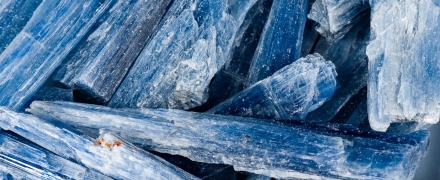open 10 am - 7 pm
laboratory is closed
Kyanite is an anisotropic rarity in the jewelry market

Kyanite is most often presented as a decorative collectible mineralogical material; it is also distributed in the form of faceted inserts in the form of cabochons and faceted cuts. In the form of tumbling inserts, the mineral is used very rarely due to the pronounced anisotropy of hardness (different indicators in two directions). The name of the mineral kyanite comes from the Greek word "kyanos" - blue, since blue is the most common color for this mineral. In Soviet literature, the name "distin" was also used, which is now considered obsolete. The best examples of cut stones come from deposits in Nepal and Tanzania, less often from India, Brazil, Kenya, Russia and Australia. At the same time, the most popular is the deep blue color, reminiscent of the color of sapphire. But colorless stones, zoned stones with colorless and blue areas, as well as rare green and yellow-orange samples are also cut. Kyanite is not widely used in the jewelry market. The main reason for this is the difficulty in cutting this inexpensive but beautiful stone.
В геммологической практике бывают весьма увлекательные случаи с диагностикой ювелирных вставок
Но помимо редкости цвета и высокой стоимости таких камней, многие розовые камни выделяются одной замечательной особенностью – они проявляют плеохроизм, то есть в зависимости от положения осмотра камня он может иметь дополнительные оттенки – оранжевый или пурпурный.
Currently, gemstones are produced by two fundamentally different technological methods - the High Pressure - High Temperature method (“HPHT”, High-pressure & High-temperature) and the Chemical Vapor Deposition (“CVD”, Chemical vapor deposition) method. The "HPHT" method is the most tested classical synthesis method, which can be used both carbon deposition on diamond from flux melts and catalytic reactions. In "CVD" synthesis, diamond growth occurs on a seed during carbon deposition mainly from a gaseous medium at relatively low temperatures and pressures.
Jewelry and precious stones are just such a category of goods, when buying which you need to pay attention to many criteria.
Sogdianite is a rather rare mineral and more often it can be found as a collection material (moreover, in systematic collections), and it is extremely rare in jewelry.






